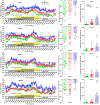Effects of Chronic Nicotine Inhalation on Systemic and Pulmonary Blood Pressure and Right Ventricular Remodeling in Mice
- PMID: 32172623
- PMCID: PMC7145734
- DOI: 10.1161/HYPERTENSIONAHA.119.14608
Effects of Chronic Nicotine Inhalation on Systemic and Pulmonary Blood Pressure and Right Ventricular Remodeling in Mice
Abstract
Cigarette smoking is the single most important risk factor for the development of cardiovascular and pulmonary diseases; however, the role of nicotine in the pathogenesis of these diseases is incompletely understood. The purpose of this study was to examine the effects of chronic nicotine inhalation on the development of cardiovascular and pulmonary disease with a focus on blood pressure and cardiac remodeling. Male C57BL6/J mice were exposed to air (control) or nicotine vapor (daily, 12 hour on/12 hour off) for 8 weeks. Systemic blood pressure was recorded weekly by radio-telemetry, and cardiac remodeling was monitored by echocardiography. At the end of the 8 weeks, mice were subjected to right heart catheterization to measure right ventricular systolic pressure. Nicotine-exposed mice exhibited elevated systemic blood pressure from weeks 1 to 3, which then returned to baseline from weeks 4 to 8, indicating development of tolerance to nicotine. At 8 weeks, significantly increased right ventricular systolic pressure was detected in nicotine-exposed mice compared with the air controls. Echocardiography showed that 8-week nicotine inhalation resulted in right ventricular (RV) hypertrophy with increased RV free wall thickness and a trend of increase in RV internal diameter. In contrast, there were no significant structural or functional changes in the left ventricle following nicotine exposure. Mechanistically, we observed increased expression of angiotensin-converting enzyme and enhanced activation of mitogen-activated protein kinase pathways in the RV but not in the left ventricle. We conclude that chronic nicotine inhalation alters both systemic and pulmonary blood pressure with the latter accompanied by RV remodeling, possibly leading to progressive and persistent pulmonary hypertension.
Keywords: angiotensin-converting enzyme; blood pressure; hypertension; hypertension, pulmonary; nicotine.
Figures






References
-
- García Calzado MC, García Rojas JF, Mangas Rojas A, Millán J. Tobacco and arterial pressure (ii.). The acute effects on the angiotensin-converting enzyme. An Med Interna. 1990;7:392–395 - PubMed
-
- Groppelli A, Giorgi DM, Omboni S, Parati G, Mancia G. Persistent blood pressure increase induced by heavy smoking. Journal of hypertension. 1992;10:495–499 - PubMed
-
- Cellina GU, Honour AJ, Littler WA. Direct arterial pressure, heart rate, and electrocardiogram during cigarette smoking in unrestricted patients. Am Heart J. 1975;89:18–25 - PubMed
Publication types
MeSH terms
Substances
Grants and funding
LinkOut - more resources
Full Text Sources
Medical

